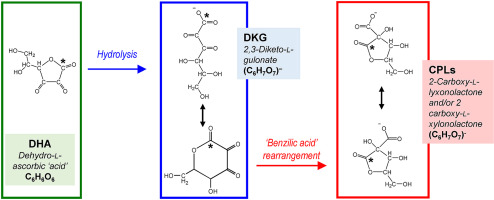当前位置:
X-MOL 学术
›
Arch. Biochem. Biophys.
›
论文详情
Our official English website, www.x-mol.net, welcomes your feedback! (Note: you will need to create a separate account there.)
Characterisation of the non-oxidative degradation pathway of dehydroascorbic acid in slightly acidic aqueous solution.
Archives of Biochemistry and Biophysics ( IF 3.9 ) Pub Date : 2019-12-26 , DOI: 10.1016/j.abb.2019.108240 Rebecca A Dewhirst 1 , Lorna Murray 2 , C Logan Mackay 2 , Ian H Sadler 2 , Stephen C Fry 1
Archives of Biochemistry and Biophysics ( IF 3.9 ) Pub Date : 2019-12-26 , DOI: 10.1016/j.abb.2019.108240 Rebecca A Dewhirst 1 , Lorna Murray 2 , C Logan Mackay 2 , Ian H Sadler 2 , Stephen C Fry 1
Affiliation

|
Although l-ascorbate (vitamin C) is an important biological antioxidant, its degradation pathways in vivo remain incompletely characterised. Ascorbate is oxidised to dehydroascorbic acid, which can be either hydrolysed to diketogulonate (DKG) or further oxidised. DKG can be further degraded, oxidatively or non-oxidatively. Here we characterise DKG products formed non-enzymically and non-oxidatively at 20 °C and at a slightly acidic pH typical of the plant apoplast. High-voltage electrophoresis revealed at least five products, including two novel CPLs (epimers of 2-carboxy-l-threo-pentonolactone), which slowly interconverted with CPA (2-carboxy-l-threo-pentonate). One of the two CPLs has an exceptionally low pKa. The CPL structures were supported by MS [(C6H7O7)-] and by 1H and 13C NMR spectroscopy. Xylonate and its lactone also appeared. Experiments with [1-14C]DKG showed that all five products (including the 5-carbon xylonate and its lactone) retained DKG's carbon-1; therefore, most xylonate arose by decarboxylation of CPLs or CPA, one of whose -COOH groups originates from C-2 or C-3 of DKG after a 'benzilic acid rearrangement'. Since CPLs appeared before CPA, a DKG lactone is probably the main species undergoing this rearrangement. CPA and CPL also form non-enzymically in vivo, where they may be useful to researchers as 'fingerprints', or to organisms as 'signals', indicating a non-oxidative, slightly acidic biological compartment.
中文翻译:

脱氢抗坏血酸在弱酸性水溶液中的非氧化降解途径的表征。
尽管l-抗坏血酸(维生素C)是一种重要的生物抗氧化剂,但其在体内的降解途径仍不完整。抗坏血酸被氧化为脱氢抗坏血酸,可以将其水解为二酮古龙酸酯(DKG)或进一步被氧化。DKG可以被氧化或非氧化进一步降解。在这里,我们表征了在20°C和植物质外体典型的弱酸性pH下非酶和非氧化形式形成的DKG产品的特征。高压电泳显示至少有五种产物,包括两种新颖的CPL(2-羧基-1-苏-戊戊内酯的末端),可缓慢与CPA(2-羧基-1-苏-戊戊酸酯)互变。两个CPL之一具有异常低的pKa。MS [(C6H7O7)-]以及1H和13C NMR光谱支持CPL结构。木糖酸盐及其内酯也出现了。用[1-14C] DKG进行的实验表明,所有五种产品(包括5碳木糖酸盐及其内酯)均保留了DKG的碳1值;因此,大多数木糖酸酯是通过CPL或CPA的脱羧作用而产生的,CPL或CPA的-COOH基团之一来自“苯甲酸重排”后的DKG的C-2或C-3。由于CPL出现在CPA之前,因此DKG内酯可能是经历这种重排的主要物种。CPA和CPL在体内也以非酶形式形成,它们在研究人员中可能会以“指纹”的形式出现,或者以生物体以“信号”的形式出现,这表明它们是非氧化性的,呈弱酸性的生物区室。在苯甲酸重排后,其-COOH基团之一来自DKG的C-2或C-3。由于CPL出现在CPA之前,因此DKG内酯可能是经历这种重排的主要物种。CPA和CPL在体内也以非酶形式形成,它们在研究人员中可能会以“指纹”的形式出现,或者以生物体以“信号”的形式出现,这表明它们是非氧化性的,呈弱酸性的生物区室。在苯甲酸重排后,其-COOH基团之一来自DKG的C-2或C-3。由于CPL出现在CPA之前,因此DKG内酯可能是经历这种重排的主要物种。CPA和CPL还会在体内以非酶形式形成,它们在研究人员中可能会以“指纹”的形式出现,或者以生物体以“信号”的形式出现,这表明它们是非氧化性的,呈弱酸性的生物区室。
更新日期:2019-12-27
中文翻译:

脱氢抗坏血酸在弱酸性水溶液中的非氧化降解途径的表征。
尽管l-抗坏血酸(维生素C)是一种重要的生物抗氧化剂,但其在体内的降解途径仍不完整。抗坏血酸被氧化为脱氢抗坏血酸,可以将其水解为二酮古龙酸酯(DKG)或进一步被氧化。DKG可以被氧化或非氧化进一步降解。在这里,我们表征了在20°C和植物质外体典型的弱酸性pH下非酶和非氧化形式形成的DKG产品的特征。高压电泳显示至少有五种产物,包括两种新颖的CPL(2-羧基-1-苏-戊戊内酯的末端),可缓慢与CPA(2-羧基-1-苏-戊戊酸酯)互变。两个CPL之一具有异常低的pKa。MS [(C6H7O7)-]以及1H和13C NMR光谱支持CPL结构。木糖酸盐及其内酯也出现了。用[1-14C] DKG进行的实验表明,所有五种产品(包括5碳木糖酸盐及其内酯)均保留了DKG的碳1值;因此,大多数木糖酸酯是通过CPL或CPA的脱羧作用而产生的,CPL或CPA的-COOH基团之一来自“苯甲酸重排”后的DKG的C-2或C-3。由于CPL出现在CPA之前,因此DKG内酯可能是经历这种重排的主要物种。CPA和CPL在体内也以非酶形式形成,它们在研究人员中可能会以“指纹”的形式出现,或者以生物体以“信号”的形式出现,这表明它们是非氧化性的,呈弱酸性的生物区室。在苯甲酸重排后,其-COOH基团之一来自DKG的C-2或C-3。由于CPL出现在CPA之前,因此DKG内酯可能是经历这种重排的主要物种。CPA和CPL在体内也以非酶形式形成,它们在研究人员中可能会以“指纹”的形式出现,或者以生物体以“信号”的形式出现,这表明它们是非氧化性的,呈弱酸性的生物区室。在苯甲酸重排后,其-COOH基团之一来自DKG的C-2或C-3。由于CPL出现在CPA之前,因此DKG内酯可能是经历这种重排的主要物种。CPA和CPL还会在体内以非酶形式形成,它们在研究人员中可能会以“指纹”的形式出现,或者以生物体以“信号”的形式出现,这表明它们是非氧化性的,呈弱酸性的生物区室。

























 京公网安备 11010802027423号
京公网安备 11010802027423号